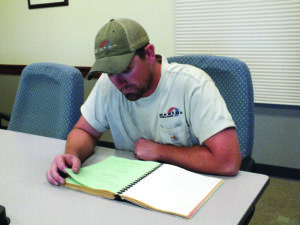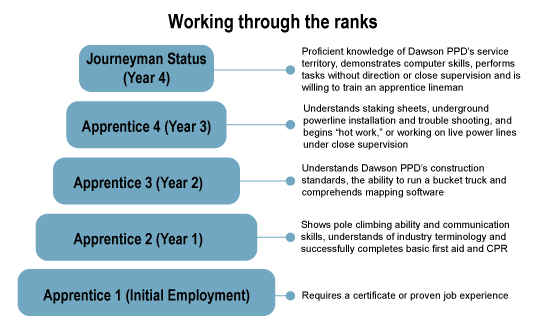
Apprentice lineman Nick Feilmeier flips through his Merchant’s Powerline Job Training and Safety Program book. He is currently studying book three of four.
Dawson PPD lineworkers obtain journeyman status through formal training program
Just because they have a utility line degree, doesn’t mean that lineworkers may officially hang up their mortar board. They’ll have to go through another four years of on-the-job training, study for and successfully pass four written tests and reach performance benchmarks before they can claim journeyman status.
According to the Bureau of Labor Statistics, electrical lineworkers rank among the top ten most dangerous jobs in the United States. The purpose of the program is to ensure that lineworkers perform their duties in the safest manner possible throughout their careers.
The Merchant’s Program
All electric utility companies have some form of higher education or a training program available for their lineworkers. Dawson PPD uses the Merchant’s Powerline Job Training and Safety Program. About 95 percent of the District’s lineworkers have completed this training or are currently in the program.
“On average, it takes the apprentice lineman four years to complete the Merchant’s Program,” said Jeremy Kaiser, Manager of Operations. “At the end of the program, we know that we have a safe, well-rounded and educated lineman out in the field.”
The Merchant’s Program is a distance-learning curriculum designed specifically for entry-level electric utility personnel. At Dawson PPD, the program is used as an apprenticeship program leading to journeyman certification and coupled with structured on-the-job training. Dawson PPD has used the Merchant’s Program since the mid-1990s.
The program consists of four books, each with 10 sections and a final exam at the end. As the lineworker completes each section of the book, a quiz is provided. They must successfully pass each section before taking the final exam.
“The books cover a lot of what was taught in school, like circuitry, first aid and knots,” Kaiser said. “It’s a good refresher for those who went through an accredited program, and for those who are ‘hired off the street’ it’s good exposure to a formal education.”
A majority of Dawson PPD’s lineworkers have received certification through an accredited program prior to their employment with the District. In the past, lineworkers were commonly trained on the job before colleges and universities introduced a utility line certification program.

Working through the ranks. Follow the guidelines to learn what each tier requires to achieve journeyman status.
Benchmarks
All Dawson PPD lineworkers are required to meet certain performance standards as set by the company. Within the apprenticeship program, there are four levels to reach before journeyman status.
As the apprentice lineworker moves through the ranks, their performance is evaluated on a biannual basis. This provides the employee with additional feedback to ensure that they successfully reach their goals.
Training
A lineworker’s training and education does not stop once they reach journeyman status. During the apprenticeship program and for the rest of their career at Dawson PPD, lineworkers are required to receive job-specific training on a rotating schedule:
- First aid and CPR
- Pole top rescue, bucket truck rescue and May Day procedure – Lineworkers learn how to rescue a colleague from a pole and bucket truck, and how to report the accident to dispatch
- Hazard communication – identify workplace hazards and read and understand safety data sheets on chemicals used within the workplace
- Commercial Driver’s License – to operate bucket trucks and other large machinery
- Switchman training – provided by Dawson PPD’s wholesale provider, Nebraska Public Power District, this training covers safe procedures in substations when rerouting or de-energizing power
- Personal grounding – proper grounding of live electrical lines prior to beginning work
- Rubber glove/hotline school and Underground school – Provided through Dawson PPD’s membership with the Nebraska Rural Electric Association, the training allows lineworkers to learn new techniques and safety procedures when working with overhead and underground power lines and equipment
- Other NREA-provided training – Trainings vary from chainsaw safety to personal protective equipment and are taught at Dawson PPD’s monthly employee safety meeting
October 2017
